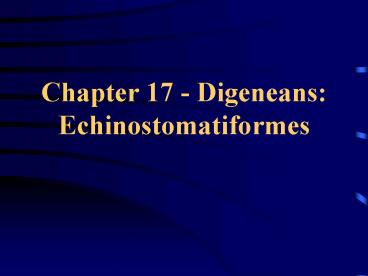Chapter 17 - Digeneans: Echinostomatiformes PowerPoint PPT Presentation
1 / 8
Title: Chapter 17 - Digeneans: Echinostomatiformes
1
Chapter 17 - Digeneans Echinostomatiformes
2
- Order Echinostomatiformes
- Tegument often has spines
- Some members of this order are among the most
common trematode parasites encountered - Some are known to cause devastating losses to
agriculture
Echinostoma sp.
- Family Echinostomatidae
- Echinostomes are recognized by the double row of
spines on the circumoral collar - The size, number and arrangement of these spines
are important for the taxonomy of the group - For the most part, these parasites are found in
the intestinal tract or bile ducts of aquatic
reptiles, birds, and mammals
3
- Genus Echinostoma
- Members of this genus are widespread and
relatively abundant - They are not extremely host specific
- Life Cycle
- Eggs hatch in water and miracidia penetrate the
first intermediate host which typically are
snails (Physa, Lymnaea, Helisoma) - The metacercaria often are found with molluscs,
planaria, fish and tadpoles - Definitive hosts pick up these parasites from
ingesting any of these hosts - Humans will become infected if they eat raw
mussels or snails - Review information pertaining to Echinostoma
revolutum in your book
4
- Family Fasciolidae
- Large worms of herbivorous mammals
- Tegument is covered with scale-like spines and
the acetabulum lies extremely close to the oral
sucker - Testes and ovaries are dendritic and the
vitellaria are extensive - No second intermediate host in their life cycle
- Metacercaria typically encyst on submerged
objects in the water
5
- Fasciola hepatica
- Rare in humans but relatively common among sheep
and cattle - Morphology
- A large fluke, reaching lengths of 30 mm and
widths of 13 mm - Testes are extremely branched
Fasciola hepatica
6
- Life Cycle
- Adults reside in the bile duct of sheep and
other ruminants - Eggs are passed with the bile into the small
intestine and are released with the feces - Eggs give rise to free swimming miracidia which
penetrate a snail host
- Miracidia transform into sporocysts which in turn
give rise to rediae - Rediae develop in the snails digestive glands
and give rise to cercariae - Cercariae attach to objects in the water and
undergo encystment as a metacercariae - Mammals pick up this infective stage when they
consume vegetation that has encysted metacercariae
7
- Life Cycle cont.
- The worms excyst in the small intestine and
penetrate the gut wall - Upon entering the coelom they crawl over the
viscera until they locate the liver - They enter the liver and begin to feed on
tissue - They eventually get into the bile ducts and
begin producing eggs - Note
- This parasite has been used to address questions
concerning how parasites locate sites within
their hosts a cue used by the worms is found in
bile (glycocholic acid)
8
- Pathology
- Most of the damage results from worms are
migrating through the liver parenchyma feeding on
liver cells and blood - Worms in the bile ducts cause inflammation and
edema - This in turn stimulates the production of
fibrous tissue in the walls of the ducts - The walls of the ducts become thickened and as a
consequence can not handle as much bile in
essence they become less responsive to the needs
of the liver - Back pressure can cause atrophy of the liver
tissue - With heavy infections the gall bladder can
become damaged

